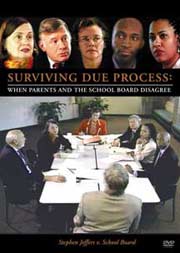|
|
Last week in Summer School for Parents you learned about your IDEA 04 rights and responsibilities. Your goal is to ensure the school provides your child with a "free appropriate public education (FAPE)."
As a parent you are a natural advocate for your child. As an advocate you need information, skills, and tools.
Last week for Assignment #3 you spent time reading. This week you will write. Get your pen and paper (or your keyboard) ready. You'll be writing lists, logs, and letters and organizing your child's file.
Yes, it will take some time and effort. It will be worth every minute if you want to negotiate a good program for your child. We have a Success Story that will show you just how it works.
In this issue of the Special Ed Advocate we explain the importance of keeping and organizing records, documentation, paper trails, and letter writing and we'll show you how to do it.
Please don't hesitate to forward this issue of Summer School for Parents to other families, friends, and colleagues.

Sign up free today! l Read previous issues |
|
| Are You Ready to Advocate? |
Here is a list of supplies that will help you get started:
- Two 3-ring notebooks (one for your child’s file; one for information about your child’s disability and educational information)
- 3-hole punch
- Highlighters
- Package of sticky notes
- #10 Envelopes
- Stamps
- Calendar
- Journal
- Contact log
- Small tape recorder
As you gather facts and information, you'll be prepared to organize your documents.
Tip: Make photocopies of all letters for your file.
 For a complete guide to advocacy skills and tools, tips and techniques, use the Special Education Survival Guide, From Emotions to Advocacy, 2nd Edition. For a complete guide to advocacy skills and tools, tips and techniques, use the Special Education Survival Guide, From Emotions to Advocacy, 2nd Edition.
Tip: See Chapter 23 and 24 for sample letters to request information and records. |
back to the top |
|
It's Time to Tackle Your Child's Special Education File - Do it Right! |
The special education system generates mountains of paper. You need a simple, foolproof document management system.
Think about the last school meeting.
Did the IEP team members have a complete copy of your child's file? Did you have a complete copy of your child's file? Is it possible for the team to make good decisions without complete, accurate information about your child?
In Organizing Your Child's Special Education File, you'll find a parent-tested system for tracking your child's educational history and a method for quickly locating any document in your child's file.
Tip: Work samples provide useful information about your child's skills. Include a few samples of your child's schoolwork when your organize the file.
Four Rules for Organizing the File
-
Do not write on your original documents.
-
Do not use a marker or highlighter on your original documents.
-
Do not release your original documents to anyone.
-
Keep your notebook current.
Assignment #4: Create a Document Management System.
Read Organizing Your Child's Special Education File. Review your child's file. If it is not complete, begin now to gather any missing information or records, organize the master file, and create your document list. Here's how, step by step.
When you take your organized file to the next school meeting, you will understand the power of getting organized. You will gain a sense of control.
If you need to ask an attorney's advice, the first thing she will want to do is review your child's file. If you have organized the file correctly, your attorney will be able understand your child's history by seeing the development step by step. |
back to the top |
|
Put That in Writing, Please! |
 Because documents are often the keys to success, advocates keep written records. Remember what Pete Wright says, "If it was not written down, it was NOT said." Because documents are often the keys to success, advocates keep written records. Remember what Pete Wright says, "If it was not written down, it was NOT said."
Good records are essential to effective advocacy. They answer questions and support memories and testimony.
Help protect your child’s interests. Train yourself to write things down!
Advocate for your child with the records you keep and the letters you write. Find out how to document everything. |
|
back to the top |
|
| How I Got the School to Change My Son's Program & Placement |
Are you still wondering "What can I do?"
As a parent, you play a big role if you know how to go about it.
Read Debbie's success story, How I Got the School to Change My Son's Program & Placement.
Debbie organized her son's file, made clear requests in writing, taped IEP meetings, and wrote letters.
Here's what happened:
"On Thursday, July 9, the district superintendent called me and said the district was 'not interested in pursuing an impartial hearing.'
In other words, we won."
Read Debbie's story about her 7 year old son with autism and what she accomplished for him. It will give you hope and a sense of direction. |
back to the top |
|
|






 Because documents are often the keys to success, advocates keep written records. Remember what Pete Wright says, "If it was not written down, it was NOT said."
Because documents are often the keys to success, advocates keep written records. Remember what Pete Wright says, "If it was not written down, it was NOT said." 

